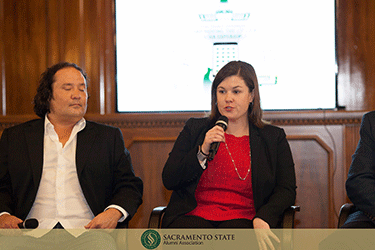 Sacramento State University recently hosted a series of events to examine what is possible when government and technology interface. CompTIA’s SLED Council is a big supporter of the Sac State Policy and Politics program and even sponsored a $5,000 scholarship for a graduate student in 2016. I spoke at one of the events this week focused on improving the citizen user experience with government. Other panelists at the event included Tim Ray, regional vice president of AT&T external affairs Northern California; Yo Yoshida, CEO and co-founder of Appallicious Inc.; and Almis Udrys, director of performance and analytics for the city of San Diego. Discussion was moderated by Maya Wallace, Performance Manager of the California Department of Justice. The discussion was great and focused on what government can do to improve citizen engagement quickly and efficiently.
Sacramento State University recently hosted a series of events to examine what is possible when government and technology interface. CompTIA’s SLED Council is a big supporter of the Sac State Policy and Politics program and even sponsored a $5,000 scholarship for a graduate student in 2016. I spoke at one of the events this week focused on improving the citizen user experience with government. Other panelists at the event included Tim Ray, regional vice president of AT&T external affairs Northern California; Yo Yoshida, CEO and co-founder of Appallicious Inc.; and Almis Udrys, director of performance and analytics for the city of San Diego. Discussion was moderated by Maya Wallace, Performance Manager of the California Department of Justice. The discussion was great and focused on what government can do to improve citizen engagement quickly and efficiently.
There was a general consensus among the panel that open government is a favorable idea and engaging citizens with government is not only desirable but crucial. The big debate was how exactly do state governments get to the point of becoming a technologically savvy engager to their customers – the citizens in their communities. A good way to start is by choosing meaningful ways to engage. An example I suggested was selecting a cause that shows impact. For example, the state of Indiana used big data to find the reasons of infant mortality in order to direct public investment. The state was able to redirect investment and show considerable impacts on mortality rates as a result.
However, there are barriers to increasing civic engagement; including funding, politics, bureaucracy and administrative resistance. None of these issues are new or surprising, as they are encountered all over government. CompTIA’s SLED Council can group every effort to improve the tech business in government into one of these broad barrier categories. One audience question really struck home, an individual asked, “What will it take to make our governments invest in technology a priority?” My answer was twofold:
First, keep fighting the good fight to raise the technology profile in government. Tech should not be thought of as its own vertical; it should be a part of every business vertical that exists and funding should follow this line of thinking. There should be no business program or initiative that is funded in government where appropriate technology is not identified as a funded priority. Second, crisis often drives opportunity in government in the forms of funding to mitigate this crisis. I used the example of the California water drought and the special legislation that funded billions of dollars to help mitigate the water drought’s effects on the state. This money helped advance a whole new industry in water technology and gave the great innovations in this area a much-needed boost. I also pointed out how a budget crisis can present an incredible opportunity to drive efficiencies within government operations. People are more motivated to change if the alternative is a pay cut or layoffs.
Civic engagement is possible, and we covered examples of great civic engagement in San Diego as well as other communities across the country. The panel did an excellent job of outlining the barriers to making this type of engagement widespread. Overcoming these barriers takes bottom-strong leadership, motivated citizens and a top-down or bottom-up strategy to drive change. CompTIA’s SLED Council membership enable this change with innovative technology and will continue to push for citizen engagement using these technologies across the U.S.

